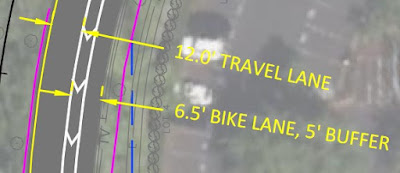Over the weekend our Strong Towns group considered a table of speed targets from Eugene. The targets were not just for signage but were engineering targets for the details of "design speed."
 |
| via FB |
Salem should absolutely do this.
But this was also a very large missed opportunity in the Metropolitan Transportation Safety Action Plan. The plan hardly mentioned design speed and reductions in posted, lawful speed.
 |
| Speeding is too casual and easy throughout the city |
The way we design roads makes it way too easy and comfortable to speed.
Previously:
- "Salem-Keizer Transportation Safety Plan needs more on Speed, not just Speeding"
- "Public Comment Calls for more Attention to Speed and Speeding in draft Safety Plan"
- "A Safety Plan too Aspirational and Questions on Front Street: At the MPO"
A concrete example where this matters is the Union Street Bikeway.
Today the 12th the Bond Implementation Committee meets, and they'll see a couple of options with bikeway revisions on the Union Street elbow where it curves to join with 12th Street.
 |
| Option 1 overview |
 |
| Option 1 detail: Buffer only and 12-foot auto travel lanes |
Though it might not only be because of our commitment to excessively high design speed, that commitment is certainly an ingredient in the inability to achieve a full "family friendly" and "all ages and abilities" standard for the bikeway.
The auto travel lanes are mostly 12 feet wide and some turn lanes are 14 feet wide. These will induce speeding around the curves and drivers will still cross over into the buffer and bike lane.
 |
| The white BMW's driver crossed over into bike lane Where Battle Creek and Pringle Roads join at Fairview |
Narrower lanes would allow for hardening the separation and better protecting people outside of cars.
But because we are still prioritizing speed and capacity, we are stuck fitting walking and biking into the leftover space rather than making walking and biking the priority. The design solutions then are often inferior because we don't also slow the cars.
From here the differences between Option 1 and Option 2 don't loom very large. The buffered bike lane will be a real improvement for confident, regular cyclists. But for those who bike infrequently or are not so confident or are kids, buffers alone will not induce large numbers of new bike trips.
See also notes on proposed Battle Creek Road configuration just past the photo above. We are not designing Battle Creek and Pringle Roads with the proximity of Leslie Middle School in mind. Design speed for cars is still much too high.
- "Fairview Hills Revives as Single Detached Housing Subdivision"
- "City Council, February 28th - Meyer Farm and Design Speeds" (2022)
Addendum, November 13th
Ben's comments below identify some details that deserve more attention.
He is right to stress the five foot buffer. That's pretty wide! I still think a buffer alone will not curb encroachment, and that the 12 foot auto travel lane will induce speeding, but five feet is relatively wide.
 |
| Five foot buffer |
Also, option 2 may not be dramatically superior, but maybe it is somewhat better than option 1.
 |
| Option 2 with southbound bike lane to Chemeteta St. (comments in black added) |
Option 1 made the primary connection to the Esplanade at Marion Street and basically employed sidewalkification. It's a refinement of the plan from earlier this year. Option 2 is new, and it makes the primary southbound connection at Chemeketa Street and the primary northbound connection at Marion Street, so it's a little bit of a one-way couplet for bike travel.
Personally I like using Chemeketa, but some in comments on the blog have argued against that, seemingly preferring to bike along Center Street between 12th and 25th. Still, even with a connection at Marion Street a person who prefers Center Street still has to jog over one block, so whether that's south from Marion or north from Chemeketa it seems a wash.
So maybe there are smaller reasons to prefer Option 2. It will be interesting to see what the Bond Committee thought.


2 comments:
I believe the differences between options 1 and two are pretty large. Option 2 extends a buffered bike lane down 12th st to Chemeketa, essential 1/2 of a road diet. I think that is pretty exciting. Eugene has a design standard for 10-11' lanes in their roadway design standards. That said, I don't think narrowing the lanes further here would make it any easier to add protection in. They propose a 5' buffer, which is pretty wide. Perhaps they could make them slightly narrower at the Marion St intersection, so they could get a 1' buffer? We need to update our roadway design standards during the TSP process so we stop running into this issue on every project.
Ben is right to stress the five foot buffer. Added more in response with pictures.
Post a Comment